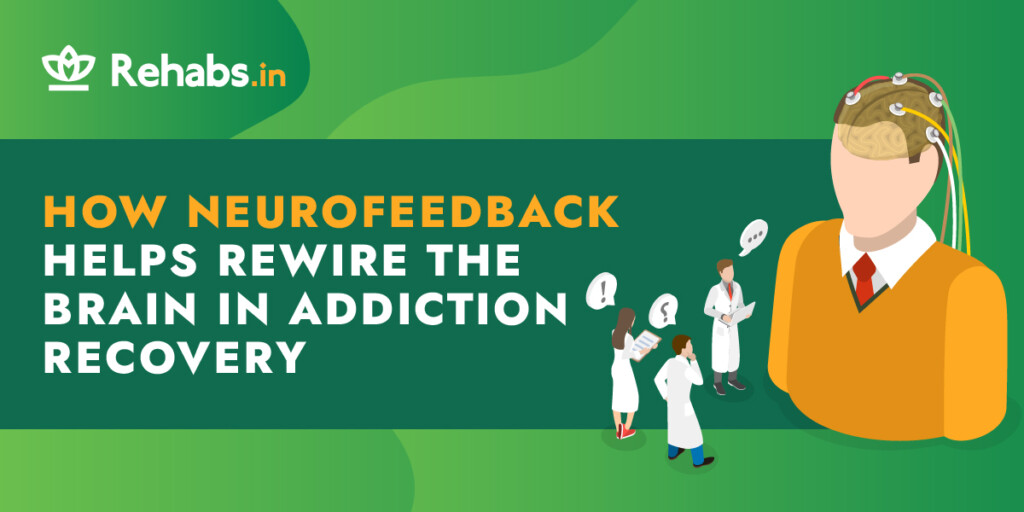How Neurofeedback Helps Rewire the Brain in Addiction Recovery

Neurofeedback therapy is a non-invasive technique that monitors and trains your brainwave activity to improve mental and emotional well-being. It uses real-time feedback from EEG (electroencephalogram) technology to help you regulate brain function. By observing your brainwave patterns, a therapist can guide you in learning how to self-regulate those patterns. This technique has been especially effective in treating conditions like addiction, anxiety, and depression.
In addiction recovery, neurofeedback therapy can play a key role in helping you retrain your brain to achieve healthier emotional and mental states. It focuses on strengthening your brain’s ability to manage stress and impulses, which are often linked to addictive behaviours. Through repeated sessions, you can rewire your brain to respond differently to triggers and cravings, paving the way for long-term recovery.
How Does Neurofeedback Work?
Neurofeedback therapy works by helping you gain control over your brain’s activity. It’s based on the idea that your brainwaves, which are electrical impulses, reflect your mental and emotional states. When these brainwave patterns become dysregulated due to stress, trauma, or substance abuse, it can lead to negative emotional states and unhealthy behaviours, such as those linked to addiction.
In a neurofeedback session, you’ll wear electrodes on your scalp that measure your brainwave activity using an EEG (electroencephalogram) device. The EEG provides real-time feedback on your brainwaves, usually in the form of visual or auditory cues, like a moving image on a screen or a sound that changes depending on your brain’s activity. This feedback allows you to see how your brain reacts to different thoughts, emotions, and behaviours, which is critical in learning to control those reactions.
Over time, and with repeated sessions, you train your brain to produce healthier patterns of brainwave activity. In the context of addiction recovery, this can help you manage cravings, reduce impulsive behaviours, and improve emotional regulation. Neurofeedback helps you rewire your brain by reinforcing the brainwave patterns that promote calmness, focus, and resilience, all of which are essential for long-term recovery.
Understanding Brainwave Activity
Your brain operates using different types of brainwaves, each associated with specific mental and emotional states. The four main brainwaves are:
- Alpha Waves: Linked to relaxation and calmness, alpha waves are active when you’re in a meditative or relaxed state.
- Beta Waves: These are associated with active thinking and problem-solving but can also be linked to stress or anxiety when overactive.
- Theta Waves: Commonly associated with deep relaxation, creativity, and intuition, theta waves are often active during meditation or light sleep.
- Delta Waves: These slow waves are dominant during deep, restorative sleep and are crucial for healing and recovery.
Measuring Brain Function with Electroencephalography (EEG)
Electroencephalography (EEG) is the tool used in neurofeedback therapy to measure brainwave activity. By placing sensors on your scalp, the EEG records electrical activity in your brain in real-time. This data is then translated into visual or auditory feedback, allowing you and your therapist to observe your brainwave patterns.
Through this process, you can learn to consciously influence these patterns. For example, if your beta waves spike due to stress or cravings, you’ll be able to see this response on the feedback screen and work on reducing that activity. With practice, neurofeedback can help you regulate your brain’s activity, promoting healthier emotional responses and aiding in addiction recovery.
Benefits of Neurofeedback in Addiction Recovery
Neurofeedback therapy offers several key benefits that can support your journey toward overcoming addiction. By training your brain to develop healthier patterns of activity, you can reduce cravings, improve emotional regulation, and enhance cognitive functions. This non-invasive method helps you build the mental resilience needed to manage triggers and prevent relapse, all while promoting overall brain health. Let’s explore some of the specific benefits neurofeedback provides in addiction recovery.
Reducing Cravings
One of the most significant challenges in addiction recovery is managing cravings. Neurofeedback helps by retraining your brain to respond differently to the triggers that typically lead to cravings. Addiction often disrupts your brain’s natural reward pathways, making you more vulnerable to urges. By providing real-time feedback on your brainwave activity, neurofeedback helps you become aware of when your brain is entering a state associated with cravings, like overactivity in beta waves or dysregulated theta waves. With practice, you learn to reduce these patterns and strengthen brainwave activity that supports calmness and control, ultimately reducing the intensity and frequency of cravings.
Enhancing Emotional Regulation
Addiction can impair your ability to manage stress, anger, and impulsive behaviours, all of which are critical in maintaining sobriety. Neurofeedback therapy helps you regain control over these emotional responses. By observing how your brain reacts to stressful or triggering situations, you can learn to down-regulate overactive brainwave patterns linked to anxiety or frustration. This improved regulation of brain activity translates to better emotional stability.
Improving Cognitive Functions
In addition to emotional benefits, neurofeedback therapy can also enhance your cognitive functions, which are often affected by substance use. Chronic addiction can impair attention, focus, and memory. Neurofeedback works to repair these functions by promoting healthy brainwave patterns that support cognitive performance. For example, it can help boost alpha and theta waves, which are linked to creativity, problem-solving, and relaxed focus.
Neurofeedback and Co-occurring Disorders
Addiction often doesn’t occur in isolation. Many individuals struggling with substance use disorders also experience co-occurring mental health conditions, such as anxiety, depression, or post-traumatic stress disorder (PTSD). These conditions can make recovery more challenging as they create additional emotional and psychological hurdles.
Addressing Anxiety and Depression
Anxiety and depression are common co-occurring conditions with addiction, as they can either contribute to or result from substance use. Neurofeedback therapy helps by stabilising the brainwave patterns that are often linked to emotional dysregulation in these conditions. For example, people with anxiety tend to have overactive beta waves, which are associated with excessive worry and stress. Neurofeedback helps you train your brain to reduce this overactivity, promoting a state of calm and focus. In cases of depression, where theta waves may be dysregulated, neurofeedback helps balance these waves, which can enhance mood and decrease depressive symptoms.
Managing Stress and Trauma
Stress and trauma are frequently at the root of addiction, driving individuals to use substances as a way to cope. Neurofeedback can be a powerful tool in addressing these underlying issues. When you experience chronic stress or trauma, your brain tends to remain in a heightened state of arousal, with overactive beta waves and reduced alpha waves, which are needed for relaxation. Neurofeedback helps you train your brain to shift out of this heightened state and enter more balanced, relaxed patterns. This is particularly important for individuals with PTSD or those who have experienced significant trauma, as it allows your brain to recover from the persistent overactivation that fuels both emotional distress and addictive behaviours.
Integration with Traditional Therapies
While neurofeedback therapy is a powerful tool in addiction recovery, it’s most effective when integrated with traditional treatment approaches. Combining neurofeedback with therapies like Cognitive Behavioral Therapy (CBT) or medication-assisted treatments (MAT) offers a comprehensive approach to recovery, addressing both the biological and psychological aspects of addiction. By working together, these therapies create a more robust treatment plan, improving your chances of long-term success.
Complementing Cognitive Behavioral Therapy
Cognitive Behavioral Therapy (CBT) is a widely used approach in addiction recovery that helps you recognise and change unhealthy thought patterns and behaviours. Neurofeedback enhances CBT by improving your brain’s ability to self-regulate, making it easier to stay focused during therapy sessions. When your brain is calmer and more balanced, you can better engage with the cognitive techniques being taught in CBT, such as challenging irrational thoughts or managing stress.
Enhancing Medication-Assisted Treatments
For some individuals, medication-assisted treatment (MAT) is a necessary part of addiction recovery, especially when dealing with severe substance use disorders. Neurofeedback can complement MAT by promoting brain healing and helping you reduce reliance on medications over time. While MAT helps manage withdrawal symptoms and reduce cravings, neurofeedback works on rewiring the brain, promoting long-term recovery. Over time, neurofeedback may even reduce the need for pharmaceutical interventions as your brain becomes more capable of managing stress, cravings, and emotional regulation without external aids.
Neuroplasticity within Addiction Recovery
Neuroplasticity is a key concept in understanding how the brain heals from addiction and adapts to healthier patterns of behaviour. The brain’s ability to rewire itself through neuroplasticity is at the heart of recovery, and neurofeedback therapy plays a significant role in this process. By encouraging new neural connections and promoting healthier brainwave activity, neurofeedback helps you reshape your brain’s pathways, making long-term recovery more achievable.
Definition and Significance of Neuroplasticity
Neuroplasticity refers to the brain’s ability to adapt, reorganise, and form new neural connections throughout life. This capability is particularly important in addiction recovery, as substance abuse can alter brain structures and functions, reinforcing harmful behaviours and thought patterns. Neuroplasticity allows your brain to recover from these changes, creating new pathways that support healthier habits and emotional regulation. In recovery, fostering neuroplasticity means helping your brain “unlearn” the addictive behaviours that have been reinforced over time and replacing them with positive, adaptive responses.
How Neurofeedback Fosters Neuroplasticity
Neurofeedback therapy directly stimulates neuroplasticity by training your brain to create new, healthier patterns of activity. During a neurofeedback session, you receive real-time feedback on your brainwave patterns, which encourages your brain to adjust and regulate its activity. This process strengthens the neural connections associated with calmness, focus, and emotional stability while weakening the connections linked to cravings, stress, and impulsive behaviours. As you repeat these sessions, your brain begins to reorganize itself, reinforcing healthier brainwave patterns. Over time, this rewiring becomes more permanent, helping you build resilience against triggers and stressors that could lead to relapse.
The Role of Self-Regulation in Recovery
Self-regulation is a crucial skill in addiction recovery, allowing you to manage your thoughts, emotions, and behaviours in a healthier way. Neurofeedback therapy plays a key role in helping you develop this ability by training your brain to respond differently to stress, cravings, and emotional challenges. Through repeated neurofeedback sessions, you learn to control your brainwave patterns, build awareness of your mental processes, and enhance your ability to self-regulate in difficult situations.
Training Individuals to Control Brainwave Patterns
One of the primary goals of neurofeedback therapy is to teach you how to control your brainwave activity. During each session, you receive real-time feedback that shows how your brain responds to different thoughts or emotional states. This feedback helps you become more attuned to your brain’s activity, allowing you to consciously adjust your brainwave patterns to promote relaxation, focus, and emotional stability. For example, if your brain enters a state of anxiety or stress, you can learn to reduce the overactive beta waves associated with those emotions.
Building Awareness of Mental Processes
Neurofeedback therapy also helps you develop a deeper awareness of your mental processes. By seeing how your brain reacts to different stimuli, you become more aware of your thoughts, emotions, and physical responses in real-time. This heightened awareness is essential for recognising the triggers that lead to cravings or emotional instability. For instance, if you notice a pattern of brain activity that typically precedes stress or impulsive behaviour, you can take steps to intervene before those feelings escalate.
Challenges and Limitations
While neurofeedback therapy has shown promise in addiction recovery, it’s important to recognise that the process comes with certain challenges and limitations. As with any treatment, individuals may experience different outcomes, and the scientific community continues to explore the full potential of neurofeedback. Understanding these challenges can help you manage expectations and make informed decisions about integrating neurofeedback into your recovery journey.
Variability in Individual Responses
One of the key challenges of neurofeedback therapy is the variability in how individuals respond to the treatment. Some people may see noticeable improvements after just a few sessions, while others might take longer to experience the benefits. Factors such as the severity of addiction, the presence of co-occurring mental health conditions, and the individual’s brainwave patterns can all influence the effectiveness of neurofeedback. Additionally, consistency is crucial—regular sessions are typically needed to reinforce new brainwave patterns and promote long-term changes.
Need for Ongoing Research
While neurofeedback has gained traction as a promising tool in addiction recovery, more research is needed to fully understand its long-term benefits and effectiveness. Studies have shown positive outcomes, particularly in reducing cravings and improving emotional regulation, but the scientific community continues to investigate how these effects hold up over time and across different populations. Further research will help clarify the most effective protocols for using neurofeedback in addiction treatment, as well as its role in preventing relapse and supporting overall brain health.
Future Directions of Neurofeedback in Addiction Treatment
As neurofeedback therapy continues to evolve, its role in addiction treatment is expected to grow, thanks to ongoing advancements in technology and accessibility. The future holds promising developments that could make neurofeedback an even more effective and widely available tool for those seeking recovery from addiction. By leveraging innovative techniques and improving accessibility, neurofeedback may become a standard part of comprehensive addiction treatment programs.
Innovative Techniques and Technologies
Emerging technologies in neurofeedback therapy are improving the way brain activity is monitored and trained. More sophisticated EEG devices are being developed, offering greater accuracy and real-time tracking of brainwave patterns. In addition, advancements in software are enhancing the feedback process, making it more interactive and tailored to individual needs. For example, newer systems can provide detailed insights into specific brainwave imbalances, allowing therapists to create highly customised training programs.
Expanding Accessibility in Recovery Programs
One of the key future directions for neurofeedback is making it more accessible to a wider range of individuals in addiction recovery. Efforts are underway to integrate neurofeedback into standard rehab programs, providing more people with access to this powerful tool. Additionally, remote neurofeedback sessions are becoming increasingly viable, thanks to advances in portable EEG devices and telehealth platforms. This means that individuals can continue their neurofeedback training from the comfort of their homes, maintaining consistency in their recovery even after leaving formal treatment.
Conclusion: Harnessing the Power of Neurofeedback in Recovery
Neurofeedback therapy offers a unique and powerful approach to addiction recovery by enhancing cognitive function, improving emotional regulation, and fostering neuroplasticity. Through consistent brainwave training, you can develop better control over your mental processes, reduce cravings, and build the resilience needed for long-term sobriety. As an effective complement to traditional therapies like Cognitive Behavioral Therapy (CBT) and medication-assisted treatments, neurofeedback can be an essential part of a comprehensive recovery plan.
For individuals seeking recovery and treatment centres looking to expand their offerings, neurofeedback provides a non-invasive, evidence-based tool that can significantly improve outcomes. By harnessing the brain’s ability to heal and adapt, neurofeedback paves the way for a healthier, more balanced life after addiction.
Sources:
Hammond, D. C. (2011). What is neurofeedback? Journal of Neurotherapy, 15(1), 45-64. https://doi.org/10.1080/10874208.2011.545760
Peniston, E. G., & Kulkosky, P. J. (1989). Alpha-theta brainwave training and beta-endorphin levels in alcoholics. Alcoholism: Clinical and Experimental Research, 13(2), 271-279. https://doi.org/10.1111/j.1530-0277.1989.tb00325.x
Sokhadze, E. M., Stewart, C. M., & Hollifield, M. (2007). Neurofeedback training improves executive functions and prefrontal EEG patterns in individuals with substance use disorder. Journal of Neurotherapy, 11(2), 43-54. https://doi.org/10.1300/J184v11n02_04
Scott, W. C., Kaiser, D., Othmer, S., & Sideroff, S. I. (2005). Effects of an EEG biofeedback protocol on a mixed substance abusing population. The American Journal of Drug and Alcohol Abuse, 31(3), 455-469. https://doi.org/10.1081/ADA-200056807
Trudeau, D. L. (2000). The treatment of addictive disorders by brainwave biofeedback: A review and suggestions for future research. Clinical Electroencephalography, 31(1), 13-22. https://doi.org/10.1177/155005940003100105















